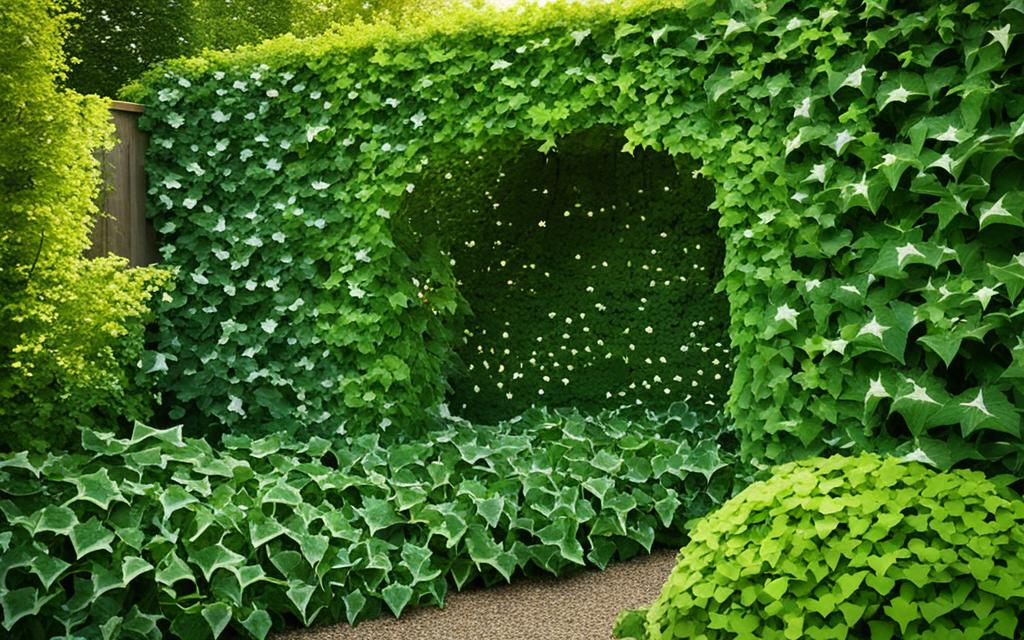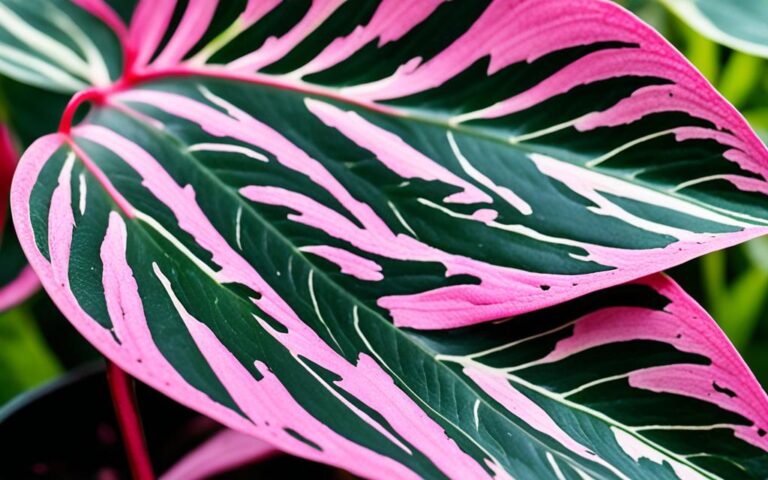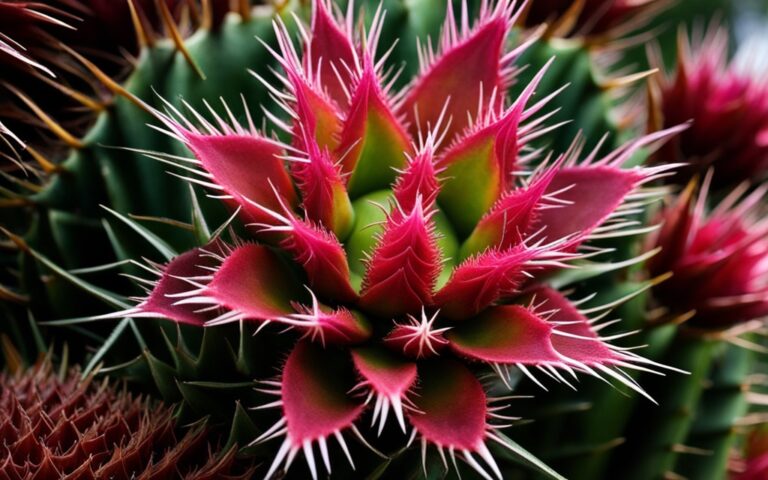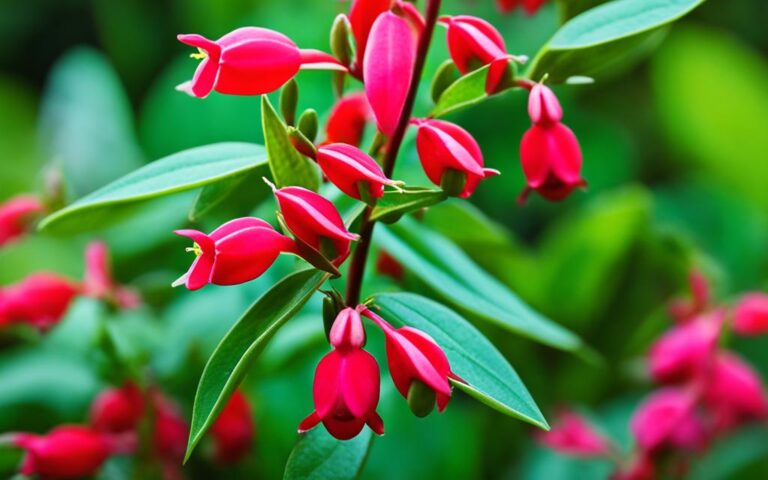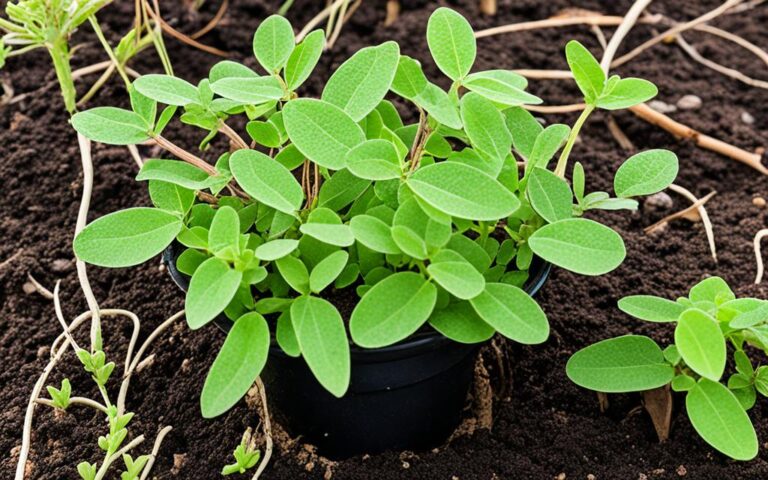Ivy Plants: Care Tips and Growing Guide for Gardeners
Did you know English ivy can grow up to 80 feet tall and spread 50 feet wide? This evergreen vine is a favorite for adding greenery to walls and buildings. But, it can be invasive, so it’s important to care for it properly.
This guide will teach you how to grow and care for ivy plants. It’s perfect for both new and experienced gardeners. You’ll learn how to make your spaces beautiful with ivy.
Key Takeaways
- English ivy is an evergreen climber that can grow up to 80 feet tall and spread 50 feet wide.
- Ivy plants provide benefits for wildlife, offering nectar, pollen, and berries for insects and birds.
- Proper care and placement are crucial to prevent ivy from becoming invasive in certain regions.
- Ivy plants thrive in partial to full shade and are hardy in USDA Zones 4 to 9.
- Ivy houseplants require well-draining soil, moderate watering, and monthly fertilization for optimal growth.
Introduction to Ivy Plants
Importance and Popularity
Ivy plants, especially English ivy (Hedera helix), are loved for their beautiful, trailing leaves. They are often used in versatile landscaping to add greenery all year. They also help wildlife by providing food and shelter.
Interesting Facts
Ivy plants change from young to mature forms. They can make buildings warmer in winter and cooler in summer. But, they can also grow too much in some places, so they need careful care.
Ivy is important in history and culture, linked to myths and symbols of loyalty and immortality. It’s used in medicine and for dye, besides being a favorite in gardens.
| Ivy Fact | Details |
|---|---|
| Wildlife Support | Ivy supports at least 50 species of wildlife, acting as an essential food source for insects and birds, especially during autumn and winter. |
| Geographical Distribution | Ivy is a common and widespread plant in the United Kingdom and Ireland, found in various habitats such as woodland, scrub, wasteland, and on isolated trees. |
| Flowering and Fruiting | Ivy is an evergreen plant that flowers from September to November and its fruits ripen between November to January. It provides nectar, pollen, and berries essential for insect and bird species. |
| Ivy Varieties | Common ivy is more common and widespread than Atlantic ivy, found throughout the UK, while Atlantic ivy is predominately found in the west of Britain and in Ireland. |
| Non-Parasitic Nature | Ivy is not a parasitic plant and does not harm trees; it uses them for support and has a separate root system in the soil. |
Ivy plants are versatile and valuable evergreen vines for landscaping and wildlife-friendly gardens. Their history and cultural significance make them a favorite among gardeners and plant lovers.
Common Ivy Species and Varieties
The world of ivy plants is full of variety, with about 15 species and hundreds of cultivars. From the well-known English ivy (Hedera helix) to the bright Algerian ivy (Hedera canariensis), there’s a wide range of Hedera species and ivy cultivars for gardeners to choose from. Each one fits different preferences and growing conditions.
Unique Characteristics of Different Varieties
Every ivy variety stands out with its own special features. These include the shape and color of the leaves and how the plant grows. For instance, the ‘Glacier’ type of English ivy has grey-green leaves with beautiful silver-grey and cream patterns. ‘Green Ripple’ has dark green leaves with clear veins. Then there are ‘Goldheart’ and ‘Goldchild’ which show off golden-yellow leaves.
| Ivy Variety | Leaf Characteristics | Growth Habit |
|---|---|---|
| English Ivy (Hedera helix) | Palmate leaves with 3-5 lobes, dark green color | Trailing, climbing, and cascading growth |
| Algerian Ivy (Hedera canariensis) | Large, leathery leaves with 3-5 lobes, glossy green | Vigorous, climbing growth |
| Japanese Ivy (Hedera rhombea) | Rhombic-shaped leaves, dark green with pale veins | Compact, mounding growth |
| Persian Ivy (Hedera colchica) | Broad, heart-shaped leaves, dark green with yellow veins | Trailing, ground-covering growth |
With so many Hedera species and ivy cultivars to choose from, gardeners can easily find the perfect one for their needs and style.
Anatomy of the Ivy Plant
Ivy plants have a unique anatomy that makes them stand out. Their leaves often have a lobed design, especially when they are young. These lobes help the plant cling to surfaces as it climbs.
The stems of ivy plants are woody and have aerial roots. These roots let the plant climb up walls and fences. As the plant grows, it produces small, greenish-yellow flowers in the fall. These are followed by black berries in the winter.
Foliage Details and Climbing Mechanism
Ivy plants have glossy, evergreen leaves that make any space look lush. Their ability to climb shows how well they have adapted over time. The aerial roots are key to their climbing ability.
| Ivy Plant Structure | Description |
|---|---|
| Leaves | Typically lobed, with more pronounced lobes in the juvenile form to aid in clinging to surfaces |
| Stems | Woody, producing aerial roots that allow the plant to climb |
| Flowers | Small, greenish-yellow flowers that bloom in the fall |
| Berries | Black berries that appear in the winter |
| Foliage | Glossy, evergreen leaves that add a touch of lush elegance |
| Climbing Mechanism | Aerial roots that enable the plant to scale walls, fences, and other structures |
The anatomy of ivy plants, from their lobed leaves to their woody stems and climbing mechanism, makes them versatile. They are popular for adding beauty and function to gardens and landscapes.
Ideal Growing Conditions for Ivy Plants
Ivy plants are adaptable and can grow in many conditions. But, they prefer certain things to grow well.
Light, Temperature, and Humidity Requirements
Ivy likes partial to full shade, especially bright, indirect light. Indoors, they can handle more sunlight, especially in winter. They grow best in temperatures between 70-90°F and like moderate humidity.
To help them grow, mist ivy plants every other day. This keeps the humidity right.
Soil, pH, and Watering Needs
Ivy can grow in many soils but does best in rich, loamy, and well-draining soil. The soil should be neutral to slightly alkaline. Make sure the soil doesn’t get too dry, as ivy doesn’t like drought.
But, it also doesn’t like wet soil. A good watering schedule is to let the soil dry out a bit between waterings.
| Environmental Factor | Ideal Conditions for Ivy Plants |
|---|---|
| Light | Partial to full shade, with bright, indirect light |
| Temperature | 70-90°F |
| Humidity | Moderate, with regular misting |
| Soil | Rich, loamy, and well-draining with a neutral to slightly alkaline pH |
| Watering | Moderate, allowing soil to slightly dry out between waterings |
By giving ivy the right conditions, gardeners can help them grow well. This makes their foliage lush and trailing.
Propagation Methods for Ivy Plants
Ivy plants are easy to grow and share. You can expand your ivy or share it with friends using simple methods. The top way is stem cuttings, which let you make new plants from parts of the existing ivy.
To start, take 4-5 inch pieces from the plant. Cut off the lower leaves, leaving a few at the top. Put the cut ends in water. For quicker roots, dip them in rooting hormone before planting. In a few weeks, roots will start to grow, and you can move the cuttings to soil.
Division is another great way to spread ivy. Ivy naturally sends out stems that root when they touch soil. Just divide and replant these rooted sections to make new plants easily.
- Ivy plant propagation can be done through stem cuttings or division
- Take 4-5 inch stem segments, remove lower leaves, and place in water to root
- Rooting hormone can speed up the process
- Ivy also naturally spreads by sending out rooting stems, allowing for easy division
Choosing any method, ivy is easy to spread and share. With some care, you can fill your space with the beautiful, trailing look of this classic plant.
Care and Maintenance of Ivy Plants
Caring for ivy plants is key to their health and long life. It’s important to use the right pruning methods and training. This helps control their size, shape, and growth.
Pruning and Training Techniques
The best time to prune ivy is in the spring. Pruning keeps the plant looking good and at the right size. Using supports or frames lets gardeners shape the plant. This shows off its beauty and flexibility.
Common Pests, Diseases, and Their Management
Ivy plants face many pests and diseases. Aphids, mites, mealybugs, and scales are common problems. These pests can be fought with neem oil or insecticidal soap.
Diseases like leaf spot and root rot can happen too. To stop these from spreading, remove any affected plants.
Fertilizers and Pesticides
Ivy plants do well with a balanced 20-20-20 fertilizer during the growing season. But, don’t overdo it, as it can cause too much growth and problems. When using pesticides, be careful. Think about how it might affect wildlife and the environment.
| Pest/Disease | Symptoms | Treatment |
|---|---|---|
| Aphids | Stunted growth, yellowing leaves, sticky honeydew | Neem oil, insecticidal soap |
| Spider Mites | Webbing, discolored leaves, premature leaf drop | Insecticidal soap, increase humidity |
| Leaf Spot | Circular brown or black spots on leaves | Remove affected leaves, improve air circulation |
| Root Rot | Wilting, yellowing leaves, foul-smelling roots | Improve drainage, reduce watering |
Knowing how to care for ivy plants ensures they stay healthy and fun for gardeners.
Benefits of Growing Ivy Plants
Growing ivy plants has many benefits beyond their good looks. They help the environment and support local wildlife. Adding ivy to your landscape is a smart choice.
Ivy plants keep buildings warm in winter and cool in summer. This means you use less energy and save money. They also stop weeds from growing and add beauty to your yard.
- Ivy plants offer excellent cover and nesting sites for birds, bats, and small mammals, providing a valuable habitat for local wildlife.
- The flowers of ivy plants provide a late-season nectar source for pollinators, such as bees and butterflies, supporting the local ecosystem.
- The berries produced by ivy plants serve as a vital food source for birds during the winter months.
English ivy is known for its health benefits. It has anti-inflammatory and antioxidant properties. It can help with upper respiratory issues.
Studies show ivy leaf extract helps kids with coughs. It has eased cough symptoms in over 5,000 children.
| Benefit | Description |
|---|---|
| Air Purification | English ivy is acknowledged as a top 10 air-purifying plant by NASA, making it an excellent choice for indoor air purification. |
| Erosion Control | The dense growth of ivy plants is beneficial for erosion control, particularly advantageous for outdoor gardeners seeking soil stabilization. |
| Sound Absorption | English ivy is mentioned to provide sound absorption benefits, contributing to a quieter living environment in urban settings. |
Ivy plants offer more than just beauty. They help the environment, support wildlife, and can be good for your health. They are a smart choice for gardeners and homeowners.
Ivy Plants: Care Tips and Growing Guide for Gardeners
Ivy plants are great for gardeners who want easy-to-care-for foliage all year. They’re perfect as climbing vines, ground covers, or indoor plants. This guide will teach you everything about taking care of these amazing plants.
Understanding Ivy’s Life Cycle and Anatomy
About 10 years after planting, English ivy changes from a young to an adult stage. The leaves change shape, becoming less lobed. It’s a late source of food for insects, offering green-yellow flowers.
Ivy sticks to surfaces without needing wires. It grows adventitious roots along its stems.
Ideal Growing Conditions for Ivy Plants
English ivy grows well in any soil, in sun or shade, but avoid waterlogged or acidic soil. It’s drought-tolerant and usually trouble-free, but might get leaf spots from infections. Variegated English ivy brightens up shady spots.
Caring for and Maintaining Ivy Plants
To keep English ivy in check, cut off any unwanted growth in spring. Brown tips on leaves mean the room is too warm or dry for indoor plants. Popular types include ‘Glacier,’ ‘Green Ripple,’ ‘Goldheart,’ and ‘Goldchild,’ each with unique features and sizes.
Ivy’s Benefits and Versatility
English ivy keeps buildings warm in winter and cool in summer, making it a great garden addition. But in places like the U.S. and Canada, it can spread too much, so be careful.
| Ivy Plant Characteristics | Measurements |
|---|---|
| Height | 20-80 feet (6-24 m) |
| Spread | 3-5 feet (.9-1.5 m) |
| Hardiness Zones | USDA 4-9 |
| Temperature Range | 65-85 F (18-30 C) |
| Soil pH Preference | 5.5 – 6.5 |
| Fertilizer Recommendation | 20-20-20 or 2-2-2 organic, every couple of weeks during growing season |
Ivy is a top pick for gardeners wanting a plant that’s easy to care for and looks great. By following this ivy plant growing guide and care instructions, you’ll enjoy its lush foliage and benefits all year.
Growing Ivy Plants Indoors
Ivy plants can make any indoor garden beautiful and rewarding. They have specific care needs, but with the right approach, you can grow them well. Let’s look at the key things to consider for indoor ivy plants.
Light and Water Requirements
Indoor ivy likes bright, indirect light. Some types can handle more direct sunlight, especially in winter when days are shorter. Watch your ivy’s leaves for signs of too much or too little light.
For watering, ivy plants need a moderate amount. Let the soil dry out a bit before watering again to avoid root rot. Adjust your watering based on your home’s temperature and humidity.
Soil and Fertilizer Needs
Good drainage is key for indoor ivy. Choose a potting mix that’s rich in nutrients and drains well. Adding a nitrogen-rich fertilizer during the growing season can help your ivy.
Feed your ivy every two to four weeks for better growth and color. But don’t overdo it, as too much fertilizer can harm the plant.
With the right balance of light, water, soil, and fertilizer, your indoor ivy will thrive. Understanding their needs lets you create the best environment for them.
Pruning and Shaping Ivy Houseplants
Keeping indoor ivy plants in shape needs careful pruning and training. Trimming stems that grow too much keeps them full and bushy. Prune English ivy in early spring to help it heal and grow new stems as it gets warmer.
To get a neat shape, use wire frames or moss-covered supports for ivy. This lets you guide the vines as they grow, making unique shapes. Don’t cut off too much at once, taking no more than one-third of the plant to keep it healthy.
Use sharp pruning shears for cuts up to 3/4 inches thick. Clean the blades with alcohol after each cut to stop diseases from spreading. Properly pruning and training ivy houseplants keeps them looking good and growing well.
“Ivy plants should be pruned moderately, with a general guideline of not removing more than one-third of the plant at a time to ensure its health and vitality.”
If ivy gets too big, cut the vines at chest height to find and remove any you miss. These will die off naturally. Make sure to throw away ivy safely, as composting might not kill it. Dispose of it with regular trash instead.
Regular pruning and shaping keeps indoor ivy looking great and growing well. It stops them from getting too leggy. By following these tips, gardeners can enjoy their ivy houseplants for many years.
Repotting and Propagating Indoor Ivy
Ivy plants do well both indoors and outdoors. They come in compact types perfect for indoor decor and can trail from shelves or mantels. As they grow, they need to be moved to bigger pots to fit their roots.
When it’s time to repot your indoor ivy, pick a new pot that’s just a bit bigger. This stops the soil from getting too wet, which can cause root rot. Carefully take the plant out of its old pot without hurting the roots. Then, put it in the new pot with fresh, well-draining soil.
You can also grow more ivy plants indoors by taking cuttings. Take cuttings a few inches long, remove the lower leaves, and root them in water or potting mix. In a few weeks, these cuttings will grow roots and can be moved to make new plants.
Propagating ivy is a great way to get more houseplants for free. After six to eight weeks, the new plants can be moved to pots and added to your indoor garden.
According to expert gardener Tony O’Neill, “It’s important to choose a healthy ivy stem, cut it below a node, and change the water every three to four days to support root development.”
Ivy plants are usually easy to care for. But, in some places, they can spread too much. Before planting ivy outside, check your local laws to make sure it’s okay for your area.
Pest and Disease Management for Indoor Ivy
Indoor ivy plants are usually easy to care for but can sometimes face pests and diseases. Keeping an eye on them and taking good care is crucial for their health and beauty.
Aphids are a common problem for indoor ivy. These tiny insects suck the sap, causing leaves to grow poorly and turn yellow. Other pests like mealybugs, scale insects, and spider mites can also harm your ivy. You can fight these pests with neem oil or insecticidal soap.
Indoor ivy can also get diseases like bacterial leaf spot and root rot. Bacterial leaf spot shows up as small, wet spots on leaves. Root rot makes leaves wilt, turn yellow, and can kill the plant. To avoid these, make sure the soil drains well and water your plant right. Remove any plants that get sick to stop the problem from spreading.
Washing leaves, keeping the right growing conditions, and dealing with pests or diseases quickly are key to keeping indoor ivy healthy. By being careful and acting fast, you can enjoy your ivy plant for many years.
| Pest/Disease | Symptoms | Treatment Methods |
|---|---|---|
| Aphids | Sap-sucking, stunted growth, yellowing leaves | Neem oil, insecticidal soap |
| Mealybugs | White, cottony masses on leaves and stems | Neem oil, insecticidal soap |
| Scale insects | Flat, brown/white scales attached to stems and leaves | Neem oil, insecticidal soap |
| Spider mites | Stippling, discoloration, webbing on leaves | Neem oil, insecticidal soap |
| Bacterial leaf spot | Small, water-soaked lesions on leaves | Remove affected leaves, improve watering and drainage |
| Root rot | Wilting, yellowing, plant death | Remove affected plants, improve watering and drainage |
“Maintaining proper growing conditions is key to preventing pest and disease issues in indoor ivy plants.”
Popular Ivy Cultivars for Indoor Growing
There are many ivy plants you can grow indoors. These plants are compact and bushy, perfect for adding beauty to your home with little work. Some top choices include:
- ‘Glacier’ with its grey-green leaves and silver-grey variegation
- ‘Green Ripple’ featuring dark green, ribbed foliage
- ‘Goldheart’ with deep green leaves splashed with yellow
- ‘Goldchild’ boasting small grey-green leaves with yellow margins
There are also many other ivy varieties that stand out. Himalayan ivy has long leaf tips, while Asterisk ivy grows well and stays small. These plants add a lush look to any room.
When picking an indoor ivy, think about how much light it needs, how big it will get, and its leaf patterns. With proper care, these plants can flourish and make your home look beautiful.
Is English Ivy Invasive?
English ivy (Hedera helix) is seen as an invasive species in many places, like the U.S. and Canada. This aggressive vine can beat out native plants and harm trees, buildings, and ecosystems. But, it’s a bigger problem outside its native Europe and Asia.
In its home area, English ivy is not as bad. Before planting it, gardeners should check if it’s invasive where they live. They can choose non-invasive vines as a better choice for their gardens.
The Invasive Nature of English Ivy
English ivy was brought over by European settlers in 1727. It has spread widely in the eastern U.S. and the West from Arizona to Washington State. It likes many conditions, from shady to sunny spots, and does well in moist, fertile soil. But, it doesn’t like drought or salty soil.
This plant is a threat to forests and open areas. It grows on the ground and up into trees, blocking sunlight. This hurts the trees by stopping them from making food, leading to their death over time.
Impacts on Ecosystems
English ivy also harms trees by carrying a disease called bacterial leaf scorch. This disease affects many trees like elms, oaks, and maples. The plant spreads by growing fast and by seeds carried by birds, making it harder to control.
Even though English ivy has many downsides, nurseries still sell it. Gardeners should think about using native plants like alumroot instead. Alumroot needs less water, keeps its leaves all year, and doesn’t cause the same problems as English ivy.
| Invasiveness of English Ivy | Native Range | Impact on Ecosystems |
|---|---|---|
| Considered a serious weed in natural ecosystems, parks, and landscapes | Europe and Asia |
|
“Once established, English ivy is very costly and labor intensive to eradicate.”
Conclusion
Ivy plants are great for gardeners, offering beauty and support for wildlife. They can grow indoors or outdoors and are easy to care for, except in areas where they might spread too much. This guide has given readers the key info to grow and care for ivy plants well.
It covers their growth habits, ideal conditions, how to spread them, prune, and handle pests and diseases. With the right care, ivy can make any garden or indoor spot look beautiful and rewarding.
English ivy’s strong roots show how well it can adapt to different places. Its close relationship with its environment and its impact on the environment highlight the importance of careful management. By following the care tips in this guide, gardeners can enjoy ivy’s benefits without the risks.
Ivy plants are a great choice for gardeners, offering beauty, environmental benefits, and practical uses. They can be used as ground cover, vines, or indoor decorations. With the right care, these hardy plants can flourish. By knowing the unique needs of different ivy types, gardeners can create beautiful, sustainable gardens that highlight the beauty and usefulness of these plants.
